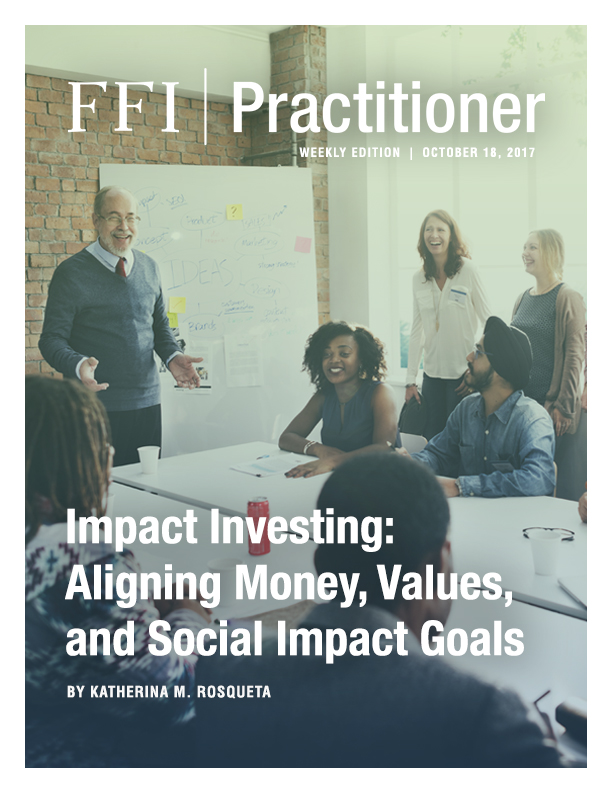You are now experiencing our new edition format! Please let us know how you like it.

From the Practitioner
This week, Katherina Rosqueta, from the Center for High Impact Philanthropy at the University of Pennsylvania, explores several approaches to impact investing, an increasingly utilized strategy to align deeply held family values with their financial investment strategy.
“Our animating principle is that all lives have equal value.”
Bill & Melinda Gates
“I am committed to the belief that we would all be in a much better place if half the human race (women) were empowered to prosper…”
Sarah Blakely
These two statements from signers of the Giving Pledge make one thing clear: for many families, philanthropic giving is an explicit way to align wealth with deeply held values. At the Center for High Impact Philanthropy, we see more families concerned not only with how their giving can achieve greater impact, but also with how their financial investments align with their values and social impact goals.
Grants going one way, Investments going another
Sometimes, families discover misalignment unexpectedly. This is what happened to Rita, the president of her family’s foundation. Reflecting the family’s deep commitment to women and children’s health, the foundation’s grants included efforts to ensure access to gynecological care and contraceptives for low-income women in the US and abroad. But when Rita examined how the foundation invested its endowment, she found that her team was using the investment guidelines of Catholic Bishops. While consistent with her family’s other values related to peace, environmental sustainability, and civil rights, that particular set of guidelines prohibits investments in companies that manufacture or sell contraceptives – the very thing to which the foundation’s grants were trying to ensure access.
Another family’s deeply-held belief that they had a responsibility to future generations led them to a philanthropic focus on environmental sustainability. But the family then struggled with what to do with the oil and gas investments they held: Should they divest, given that sector’s negative environmental impact? Should they continue to hold these assets, but engage in shareholder activism via proxy statements? Or should they decrease their holdings and shift to investing more in renewable energy?
In both cases, the families faced tension between their values and how they invested their money.
What is relatively new is the growing number of tools, resources, and education opportunities available to families seeking to align their financial investments with their values.
In search of alignment
At the Center for High Impact Philanthropy, we see more and more families looking to resolve that tension. The good news is that there are more high-profile examples that families can learn from.
For example, the Surdna Foundation, one of the oldest and largest family foundations in the United States, recently committed $100 million to impact investing – investments intended to generate both social and financial returns. Examples include a $5 million commitment to DBL Partners, a venture capital fund focused on growing companies working in areas such as cleantech and healthcare, and a $700,000 loan to Business Outreach Center, a community-development finance institution (Community Development Financial Institutions –CDFI) that supports minority and women-owned business. In both cases, these investments support the family’s multi-generational commitment to “service for those in need of help or opportunity.”
As another example, the Barra Foundation was created by wealth generated from the McNeil family’s pharmaceutical company. In 2016, the foundation made its first ‘mission-related investment,’ a type of impact investing made by foundations with the specific intention of furthering a foundation’s philanthropic goals. In Barra’s case, it was a $1 million investment in the Reinvestment Fund’s loan fund for housing, grocery stores, and businesses. That investment was intended to strengthen the same low-income communities the Barra Foundation seeks to help through its grants.
Both families actively use investment capital to work alongside their grantmaking to further their social impact goals. Equally important, both are committed to sharing what they learn. In Surdna’s case, the foundation released the publication, Mapping the Journey to Impact Investing , and a 5th generation family member and Surdna board member is sharing her family’s experience with participants in the Center for High Impact Philanthropy’s Funder Education Program.
Supporting those seeking better alignment
Aligning financial investments with values and social impact goals is not new. For more than 30 years, CDFI’s have operated as private financial institutions dedicated to addressing the needs of low-income and other disadvantaged communities. And one of the founding fathers of the United States, Benjamin Franklin, apparently “…left 2,000 pounds sterling in the form of a revolving loan fund for young artisans.” making him not only a scientist, politician, businessman, and philanthropist, but also one of the nation’s first impact investors.
What is relatively new is the growing number of tools, resources, and education opportunities available to families seeking to align their financial investments with their values.
New networks have also emerged to help families learn from and with each other. Toniic is a network of family offices, individuals and institutions committed to impact investing and peer learning. Mission Investors Exchange serves a similar role for foundations. The ImPact offers an interesting complement to the Giving Pledge. While the Giving Pledge is a commitment to give money away philanthropically, ImPact is a commitment among some of the world’s wealthiest families to invest their fortunes to improve the lives of others.
To continue to advance the field, nonprofit intermediaries such as The GIIN (Global Impact Investing Network) were created to serve as a source of tools and thought leadership for those seeking to align financial investments with values and social impact.
And for those who think a focus on social impact is just the latest fad for a fringe group of do-gooders, take note of what is happening at Wharton. The oldest collegiate business school in the US, it is best known for its preeminence in MBA finance education. Last year, more students enrolled in Professor Chris Geczy’s impact investing class than in his traditional investing class. Wharton Social Impact Initiative now has a host of student and faculty efforts focused on impact investing as a tool for addressing social problems.
Towards increased alignment and impact
This summer, over 500 people from around the world, including delegations from China, Israel, and Brazil, gathered in Chicago for the Global Impact Investment Steering Group (GSG), a global network dedicated to developing the tools, knowledge, and policy to enable better alignment between financial investments and social impact. That group included leaders from all sectors: business, government, and philanthropic/nonprofit sector. The diversity of perspectives was impressive.
What was even more striking was the shared passion of those in the room. It is a passion we’re used to seeing among the graduate students in our on-campus courses and participants who come to our center from around the world to learn how to practice high impact philanthropy. That passion never surprises us since philanthropy has always served as a way for families to act on their deepest held values and social impact goals. The crowd gathered in Chicago was focused on impact investing, not philanthropy. However, I suspect the passion comes from the same source: the desire to align actions with the values and social goals that matter most.

About the contributor
Katherina M. Rosqueta is the founding executive director of the Center for High Impact Philanthropy, a multi-disciplinary center focused on building knowledge for social impact. As adjunct faculty at the University of Pennsylvania’s School of Social Policy & Practice (SP2), she is the faculty director for the first social impact course open to graduate students of all 12 of Penn’s schools. She also leads a team of center directors, advisors, and key Penn faculty to teach and coach families, individual donors, and other philanthropic leaders on how to apply the principles of high impact philanthropy to their giving. Kat can be reached at rosqueta@upenn.edu.
About the Center for High Impact Philanthropy
The Center for High Impact Philanthropy (CHIP) is the only university-based center with a singular focus on philanthropy for social impact. Founded as a collaboration between the School of Social Policy & Practice and alumni of the Wharton School, CHIP is a trusted source of knowledge and education to help donors around the world do more good.



